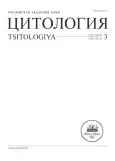Создание модельной линии опухолевых клеток с индуцируемой экспрессией аденовирусного E1A для изучения его антипролиферативных и цитотоксических свойств in vitro и in vivo
- Авторы: Моршнева А.В.1, Козлова А.М.1, Гнедина О.О.1, Иготти М.В.1
-
Учреждения:
- Институт цитологии РАН
- Выпуск: Том 66, № 3 (2024)
- Страницы: 242-252
- Раздел: Статьи
- URL: https://gynecology.orscience.ru/0041-3771/article/view/669593
- DOI: https://doi.org/10.31857/S0041377124030041
- EDN: https://elibrary.ru/PELLCN
- ID: 669593
Цитировать
Полный текст
Аннотация
В последние десятилетия генная терапия на основе аденовирусного E1A доказала свою эффективность в отношении ряда опухолевых заболеваний, как на животных моделях, так и в клинических исследованиях. Показано, что помимо собственной антипролиферативной активности, E1A также обладает способностью усиливать цитотоксический эффект некоторых противоопухолевых препаратов. Применение Е1А в комбинированной терапии может решить ряд проблем клинической онкологии, среди которых наиболее актуальными являются проблема устойчивости или невосприимчивости опухолевых клеток к цитотоксическому воздействию. В настоящей работе описано создание клеточных моделей с индуцируемой антибиотиком доксициклином экспрессией белка аденовирусного E1A на основе клеток колоректального рака человека HCT116 и цисплатин-устойчивых клеток HCT116/C. Нами показана концентрационная и временная зависимость экспрессии белка E1A от доксициклина, а также показан антипролиферативный эффект аденовирусного E1A при индукции его экспрессии в полученных клетках HCT116-E1A и HCT116/C-E1A in vitro в экспериментах по оценке жизнеспособности в тестах МТТ и клоногенной активности, а также и in vivo в ксенографтных мышиных моделях. Таким образом, в результате нашей работы была создана модель для анализа антипролиферативных и сенсибилизирующих свойств E1A в чувствительных и платино-устойчивых клетках колоректального рака и поиска новых подходов противораковой терапии in vitro и in vivo. Полученная клеточная линия является удобной моделью для подбора наиболее перспективных сочетаний цитостатиков с генной терапией на основе E1A.
Полный текст
Об авторах
А. В. Моршнева
Институт цитологии РАН
Email: marie.igotti@gmail.com
Россия, Санкт-Петербург, 194064
А. М. Козлова
Институт цитологии РАН
Email: marie.igotti@gmail.com
Россия, Санкт-Петербург, 194064
О. О. Гнедина
Институт цитологии РАН
Email: marie.igotti@gmail.com
Россия, Санкт-Петербург, 194064
М. В. Иготти
Институт цитологии РАН
Автор, ответственный за переписку.
Email: marie.igotti@gmail.com
Россия, Санкт-Петербург, 194064
Список литературы
- Baluchamy S., Sankar N., Navaraj A., Moran E., Thimmapaya B.
- Berhane S., Aresté C., Ablack J. N., Ryan G. B., Blackbourn D. J., Mymryk J. S., Turnell A. S., Steele J. C., Grand R. J.A.
- Bernhard E. J., Hagner B., Wong C., Lubenski I., Muschel R. J
- Chakraborty A. A., Tansey W. P
- Chang J. Y., Xia W., Shao R., Sorgi F., Hortobagyi G. N., Huang L., Hung M. C
- Chang Y.-W., Hung M.-C., Su J.-L.
- Cook J. L., Routes J. M
- Davis J. J., Wang L., Dong F., Zhang L., Guo W., Teraishi F., Xu K., Ji L., Fang B.
- Deng J., Kloosterbooer F., Xia W., Hung M.-C.
- Ferrari R., Su T., Li B., Bonora G., Oberai A., Chan Y., Sasidharan R., Berk A. J., Pellegrini M., Kurdistani S. K
- Frisch S. M
- Frisch S. M., Dolter K. E
- Frisch S. M., Reich R., Collier I. E., Genrich L. T., Martin G., Goldberg G. I
- Gerstberger S., Jiang Q., Ganesh K.
- Gu J., Fang B.
- Hendrickx R., Stichling N., Koelen J., Kuryk L., Lipiec A., Greber U. F
- Hofer A., Crona M., Logan D. T., Sjöberg B.-M.
- Hung M. C., Hortobagyi G. N., Ueno N. T.
- Ikeda M. A., Nevins J. R
- Konopka K., Spain C., Yen A., Overlid N., Gebremedhin S., Düzgüneş N.
- Liao Y., Zou Y.-Y., Xia W.-Y., Hung M.-C.
- Marthaler A. G., Adachi K., Tiemann U., Wu G., Sabour D., Velychko S., Kleiter I., Schöler H. R., Tapia N.
- Mendoza G., González-Pastor R., Sánchez J. M., Arce-Cerezo A., Quintanilla M., Moreno-Bueno G., Pujol A., Belmar-López C., de Martino A., Riu E., Rodriguez T. A., Martin-Duque P. 2023. The E1a adenoviral gene upregulates the Yamanaka factors to induce partial cellular reprogramming. Cells. V. 12. P. 1338.
- Pelka P., Ablack J. N.G., Fonseca G. J., Yousef A. F., Mymryk J. S
- Pelka P., Miller M., Cecchini M., Yousef A. F., Bowdish D., Dick F., Whyte P., and Mymryk J. S
- Pleshkan V. V., V P.V., Alekseenko I. V., V A.I., Zinovyeva M. V., V Z.M., Vinogradova T. V., V V.T., Sverdlov E. D., D S.E.
- Radke J. R., Cook J. L https://doi.org/10.1038/cddis.2016.445
- Radko S., Jung R., Olanubi O., Pelka P. https://doi.org/10. 1371/journal.pone.0140124
- Rao L., Debbas M., Sabbatini P., Hockenbery D., Korsmeyer S., White E.
- Rein D. T., Breidenbach M., Nettelbeck D. M., Kawakami Y., Siegal G. P., Huh W. K., Wang M., Hemminki A., Bauerschmitz G. J., Yamamoto M., Adachi Y., Takayama K., Dall P., Curiel D. T
- Saito Y., Sunamura M., Motoi F., Abe H., Egawa S., Duda D. G., Hoshida T., Fukuyama S., Hamada H., Matsuno S.
- Sánchez-Prieto R., Quintanilla M., Cano A., Leonart M. L., Martin P., Anaya A., Ramón y Cajal S.
- Shisler J., Duerksen-Hughes P., Hermiston T. M., Wold W. S., Gooding L. R
- Singhal G., Leo E., Setty S. K.G., Pommier Y., Thimmapaya B.
- Sunamura M., Yatsuoka T., Motoi F., Duda D. G., Kimura M., Abe T., Yokoyama T., Inoue H., Oonuma M., Takeda K., Matsuno S.
- Tiainen M., Spitkovsky D., Jansen-Dürr P., Sacchi A., Crescenzi M.
- Van Houdt W. J., Haviv Y. S., Lu B., Wang M., Rivera A. A., Ulasov I. V., Lamfers M. L.M., Rein D., Lesniak M. S., Siegal G. P., Dirven C. M.F., Curiel D. T., Zhu Z. B
- White E.
- Whyte P., Ruley H. E., Harlow E.
- Yamaguchi H., Chen C.-T., Chou C.-K., Pal A., Bornmann W., Hortobagyi G. N., Hung M.-C.
- Yu D., Wolf J. K., Scanlon M., Price J. E., Hung M. C
- Zemke N. R., Hsu E., Barshop W. D., Sha J., Wohlschlegel J. A., Berk A. J https://doi.org/10.1128/jvi.00993-23
- Zhu Z. B., Makhija S. K., Lu B., Wang M., Kaliberova L., Liu B., Rivera A. A., Nettelbeck D. M., Mahasreshti P. J., Leath C. A., Yamamoto M., Alvarez R. D., Curiel D.
Дополнительные файлы












